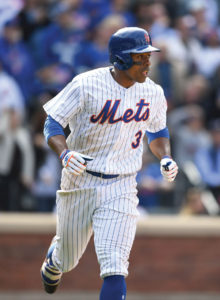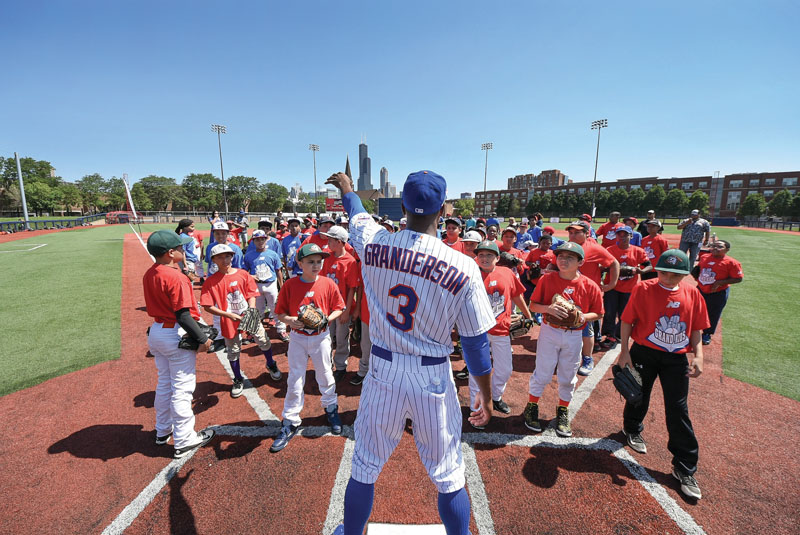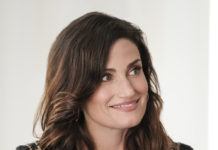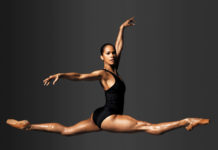Above: Curtis Granderson excels on the field and in the community. (Photos courtesy of New York Mets)
Mets’ Curtis Granderson rounds the bases
It’s easy to write off athletes as pretentious—their egos inflated by adoring fans and fawning press, their sensibilities dulled by derision from those same parties. That isn’t Curtis Granderson. A great ballplayer and a better person, he’s unaffected by his nearly 15 years in the majors. Through slumps and hot streaks, the outfielder has remained approachable in the clubhouse and charitable in the community, from Detroit through two stops in New York. Granderson talks about the fans, athletes as role models, memorable moments and more.
Q: What would you say is the main difference between the two New York fan bases?
A: With the Yankees, they’ve been so good for so long that it’s easy to have positive memories of the team, so from a historical perspective, the fans expect to win. On the Mets side, there’s an intense passion because there have been big gaps between successes. But in New York, there are so many different things that can draw a fan’s attention: two baseball teams, two basketball teams, three hockey teams, two football teams. Whereas in Michigan, the entire state gets behind [the Tigers].
Q: What is it like experiencing the Mets-Yankees rivalry from both sides?
A: I was talking to [Derek] Jeter about the 2000 World Series and he told me, “it was the World Series we had to win.” But when I first played against the Mets in the regular season, we were so locked into the American League East race, that I didn’t feel that same rivalry. And now playing for the Mets against the Yankees, it’s the same thing. As a player, you are focused on your division and your league, but we know the fans always look forward to it. No matter what the standings look like, both stadiums are packed and from the field you can see the different jerseys and how mixed up the fans are.
Q: What are some of your personal standout moments in professional baseball?
A: In Detroit, making it to the World Series in 2006. No one really expected us to. We got off to this start that no one expected. People thought it was going to fade, but it just never faded. Then there’s the milestone in 2007 (20 doubles, 20 triples, 20 home runs, 20 stolen bases. Granderson was the first to do it since Willie Mays in 1957).
 Q: Do you think athletes should be viewed as role models?
Q: Do you think athletes should be viewed as role models?
A: No matter what we do, we have a role model responsibility. At the same time I feel like the biggest role model to any individual should be those closest to you. But the reality is, including myself as a kid, there’s people I looked up to and marveled at—Ken Griffey Jr. was an idol of mine because he did things that I wanted to do one day. So when I look back, I can’t say that him or Michael Jordan were role models, they were idols and people I wanted to emulate. I think that’s where we get mixed up, because whoever you’re going to be around for 40 hours of the week should have the impact. For me, it was my mom, my dad, my neighbors, some teachers—those are the people that stand out for me.
Q: Both of your parents are educators. How did that influence how you approach baseball?
A: If anything, it helped me realize there’s always a process, and to get to wherever you want to get to, you have to take the proper steps. I always had some room to improve and I’ve always had some slight doubt against me. When I got drafted, I wasn’t strong enough to play the corners, I wasn’t fast enough to play center field and I panned out to be potentially a fourth outfielder. So I thought, “OK, how do I maximize my potential? How do I take what I have and prove people wrong?” And that’s where the process comes from. My parents would help students start somewhere, practice and then ultimately reach the result that they wanted. I think being around them and seeing that helped get me to where I am today.
Q: You started the Grand Kids Foundation in 2007. How did you decide that was the type of player you wanted to be?
A: I think I had always been doing it and didn’t know that’s what I was doing, by just watching my family. Seeing it and being around it, it became second nature. Education had always been a passion for me and that’s what I wanted to focus on. In Detroit at the time, the graduation rate was only at 50 percent, so it linked in well with where I was. We worked with Detroit Public School system and developed our first children’s book. When I was traded to New York, the foundation grew. We’ve been able to do stuff with youth baseball here, at different schools in different boroughs. We’ve been able to expand and ask what exactly is education—it’s not just going to the class, learning something and then going home. The foundation teaches kids about proper nutrition to help kids focus and pay attention. We also help kids stay in shape. If you are lethargic and out of shape, it makes it even more difficult to do the things you need to do in the classroom.





